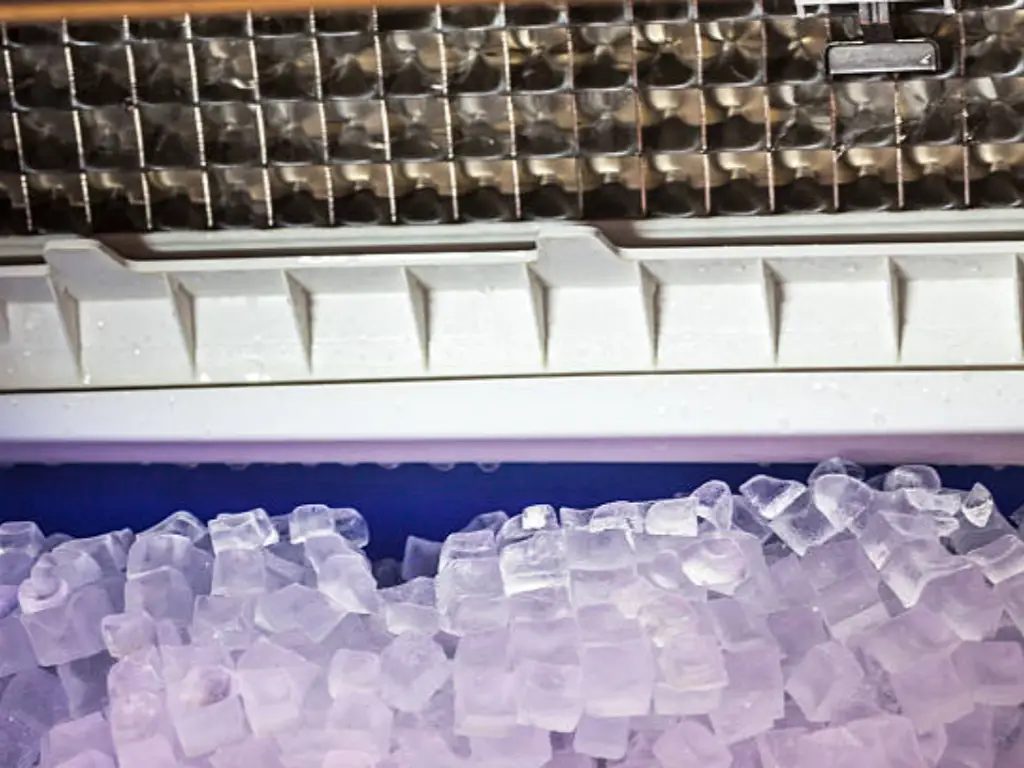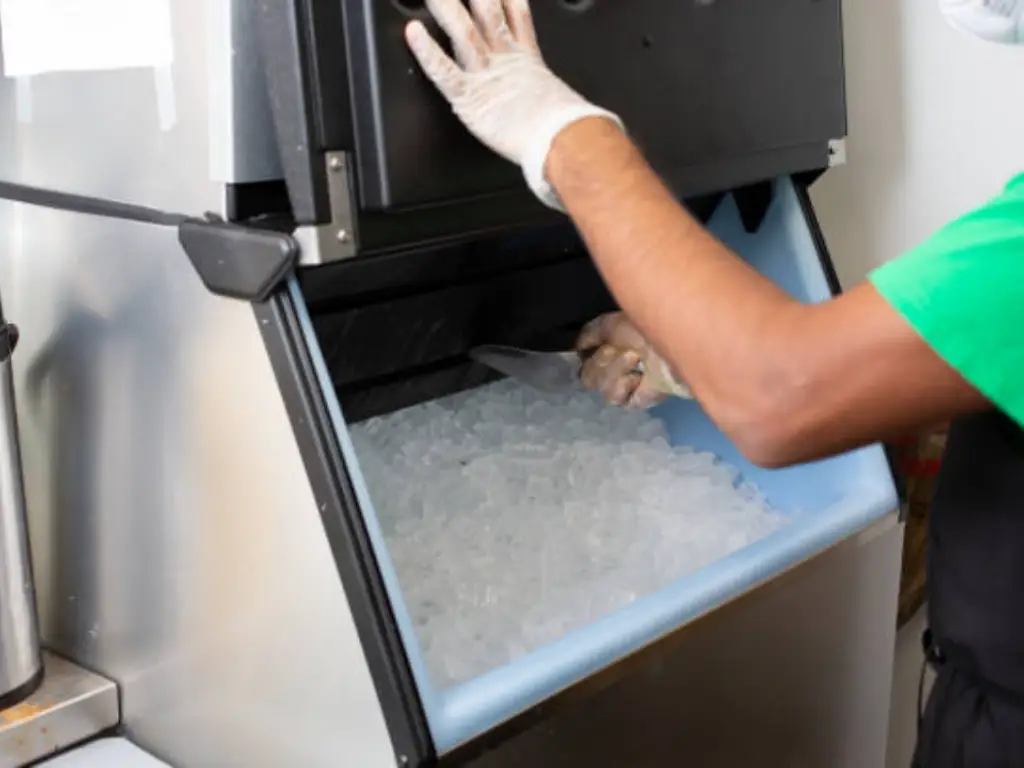| Merkmale | Eiswürfel | Eisblöcke |
| Größe | Klein | Groß |
| Form | Typischerweise quadratisch | Rechteckig oder zylindrisch |
| Verwenden | Einzelne Getränke | Große Kühlung, Carving |
| Schmelzrate | Relativ schnell | Langsamer |
| Kühlkapazität | Beschränkt | Höher |
| Verfügbarkeit | Weit verbreitet | Spezial- oder kommerzielle Quellen |
| Bequemlichkeit | Leicht zu handhaben | Benötigt spezialisierte Geräte |
Block Ice vs Cube Ice -Vergleichstabelle
Eis ist ein entscheidendes Element in einer Vielzahl von Anwendungen, Von den Kühlen von Getränken bis hin zur Erhaltung verderblicher Güter. Wenn es um Eis geht, Es gibt zwei Haupttypen, die den Markt dominieren Blockieren Sie Eis und Würfeleis. In diesem Artikel, Wir werden uns mit den Details dieser beiden Eisformen befassen, Untersuchung ihrer Merkmale, Verwendung, und Vorteile. Am Ende, Sie werden die wichtigsten Unterschiede zwischen Blockeis und Würfeleis gründlich verstehen, Ermöglichen.
Vergleich zwischen Blockeis und Würfeleis
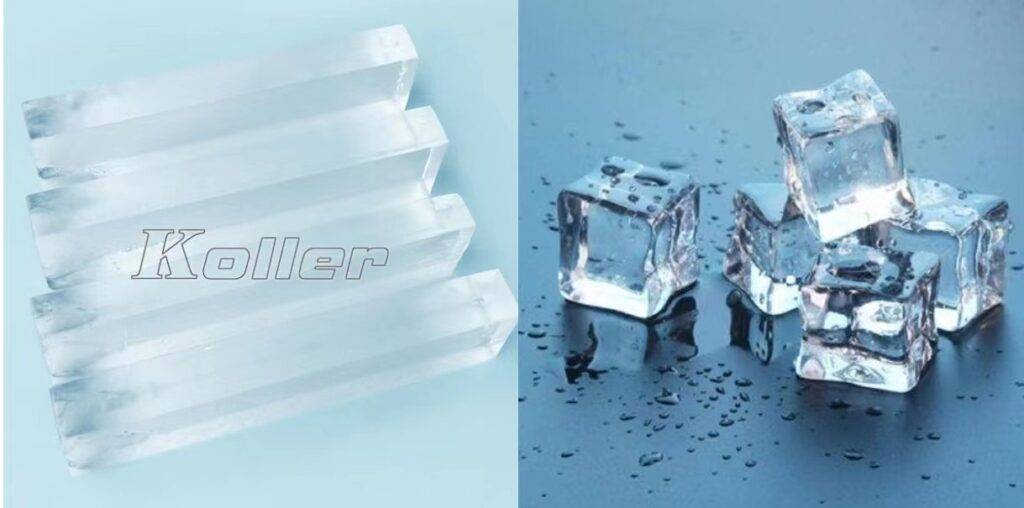
Visuelles Erscheinungsbild
Der erste spürbare Unterschied zwischen Blockeis und Würfeleis liegt in ihrem visuellen Erscheinungsbild. Eis blockieren, Wie der Name schon sagt, ist eine feste Eismasse, die typischerweise rechteckig oder quadratisch in Form ist. Es strahlt eine Aura der Stärke und Haltbarkeit aus, Dadurch für bestimmte Bewerbungen visuell ansprechend erfolgen.
Im Gegensatz, Würfeleis wird zu Uniform gebildet, kleine Würfel, die leicht in Getränkegläser passen. Cube Ice strahlt ein Gefühl von Eleganz und Raffinesse aus, Verbesserung der Gesamtpräsentation von Cocktails und Getränken.
Schmelzrate und Kühlungseffizienz
Wenn es um die Rate der Schmelz- und Kühlungseffizienz geht, Block ICE übertrifft Würfel Eis. Aufgrund seiner größeren Größe, Block -Eis dauert länger, um zu schmelzen, Gewährleistung eines anhaltenden kühlen Effekts und Reduzierung der Notwendigkeit häufiger Eisersatz. Darüber hinaus, Block Ice hat eine höhere Kühlkapazität und kann über einen längeren Zeitraum niedrigere Temperaturen aufrechterhalten.
Auf der anderen Seite, Würfeleis neigt dazu, FA zu schmelzenSter und hat eine begrenzte Kühlkapazität, Dies kann zu einer Verdünnung der Getränke im Laufe der Zeit führen.
Anwendungen und Eignung
Sowohl Blockeis als auch Cube -Eis finden ihre Anwendungen in verschiedenen Einstellungen, wenn auch mit unterschiedlichen Eignung. Eis blockieren ist besonders geeignet für Große Veranstaltungen und industrielle Anwendungen wie etwa die Lebensmittelverarbeitung, Verderbliche Waren erhalten, und Eisskulpturen schaffen. Die langsame Schmelzrate und die erweiterte Kühlkapazität machen es zu einer zuverlässigen Wahl für diese Zwecke.
Würfeleis, auf der anderen Seite, wird häufiger in verwendet in Individuelle Getränke, Home -Einstellungen, und kleine Veranstaltungen. Die bequeme Größe und schnelle kühle Eigenschaften machen es ideal für den persönlichen Gebrauch und die intimen Versammlungen.
Verfügbarkeits- und Komfortfaktoren
Eine der wesentlichen Überlegungen bei der Auswahl zwischen Blockeis und Würfeleis ist ihre Verfügbarkeit und Bequemlichkeit. Würfeleis ist weit verbreitet und kann leicht in Convenience Stores erhalten werden, Supermärkte, Und Eiswürfel -Maschinen machen. In den meisten Haushalten ist es ein Grundnahrungsmittel, Gewährleistung eines sofortigen Zugangs zu Eiswürfeln, wann immer erforderlich.
Umgekehrt, Eis blockieren Möglicherweise ist nicht so leicht zugänglich und erfordert möglicherweise besondere Vorkehrungen zum Kauf oder Vorbereitung. Die größere Größe und Spezialisierung von Blockeis trägt zu seiner relativen Knappheit und begrenzten Verfügbarkeit bei.
Was ist ein Eiswürfel?
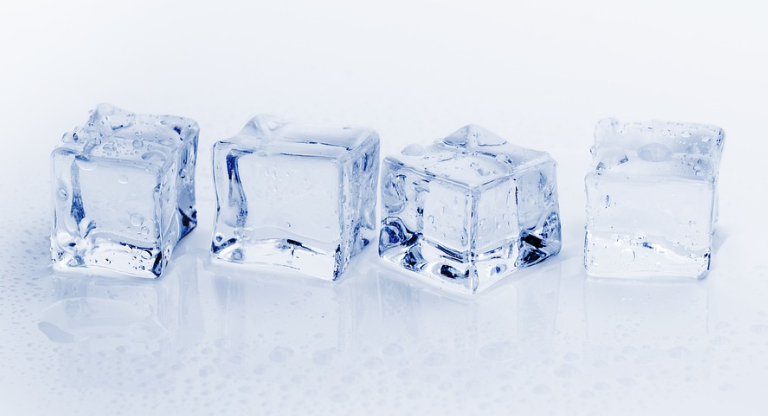
Ein Eiswürfel ist klein, Typischerweise quadratisches Stück Eis, das üblicherweise zum Abkühlen von Getränken oder in verschiedenen anderen Anwendungen verwendet wird. Es wird durch Einfrieren von Wasser in einem Behälter mit bestimmten Abmessungen erstellt, was zu einem soliden führt, einheitliche Form.
Anwendung von Eiswürfeln

Eiswürfel haben eine Vielzahl von Verwendungsmöglichkeiten, einschließlich kühlender Getränke, Verderbliche Lebensmittel bewahren, Bereitstellung von Erleichterungen für geringfügige Verletzungen, Und selbst als Basis für die Herstellung von gefrorenen Getränken und Cocktails. Sie werden auch häufig in der Foodservice -Industrie für Ausstellungszwecke und im medizinischen Bereich für therapeutische und Genesungszwecke verwendet.
Vor- und Nachteile von Eiswürfeln
- Bequemlichkeit und einfache Verfügbarkeit: Einer der Hauptvorteile von Eiswürfeln ist ihre Bequemlichkeit. Sie können zu Hause mit minimaler Aufwand leicht gekauft oder hergestellt werden.
- Geeignet für individuelle Getränke und Heimgebrauch: Eiswürfel sind ideal für einzelne Getränke, da sie leicht in ein Glas oder eine Tasse passen können. Sie werden auch häufig in Heimkühlschränken und Eismachern eingesetzt.
- Schnellere Schmelzrate und begrenzte Kühlkapazität: Ein Nachteil von Eiswürfeln ist ihre relativ schnelle Schmelzrate im Vergleich zu größeren Eisblöcken. Sie haben auch eine begrenzte Kühlkapazität, Sie sind weniger geeignet, um größere Mengen an Gegenständen über einen längeren Zeitraum abzukühlen.
Wie man klare Eiswürfel macht?
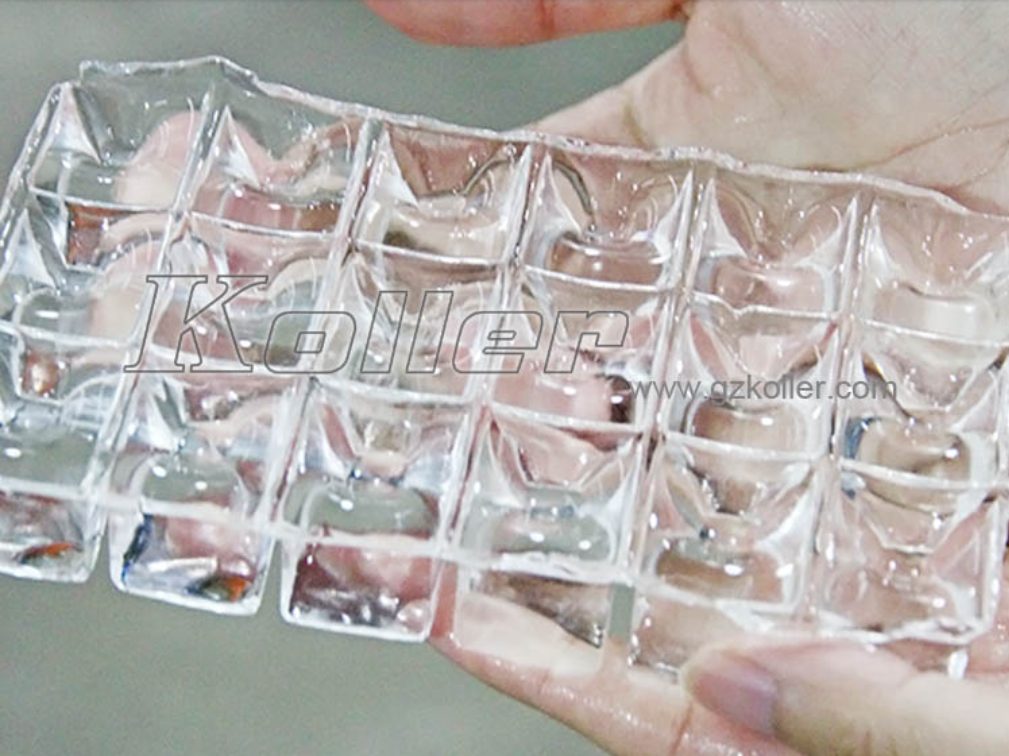
Klare Eiswürfel sind sehr gefragt für ihre visuell ansprechende Qualität. Im Gegensatz zu normalen wolkigen Eiswürfeln, Klare Eiswürfel haben ein kristallklares Aussehen, Verbesserung der gesamten Präsentation von Getränken und Cocktails.
Schritt-für-Schritt-Anleitung zur Herstellung klarer Eiswürfel
- Wählen Sie Ihre bevorzugte Methode, Ob es die kochende Wassertechnik ist, Richtungsfrieren, Oder mit destilliertem Wasser, und befolgen Sie diese allgemeinen Schritte:
- Bereiten Sie das Wasser durch Kochen vor, Kühlung, Oder mit destilliertem Wasser.
- Gießen Sie das vorbereitete Wasser in Eiswürfelschalen, einen kleinen Raum an der Spitze lassen, um beim Einfrieren auszudehnen.
- Legen Sie die Tabletts in den Gefrierschrank und lassen Sie sie vollständig einfrieren.
- Entfernen Sie die Eiswürfel von den Schalen und lagern Sie sie in einem versiegelten Behälter oder Plastiktüte im Gefrierschrank, bis sie benötigt werden.
Was ist ein Eisblock?
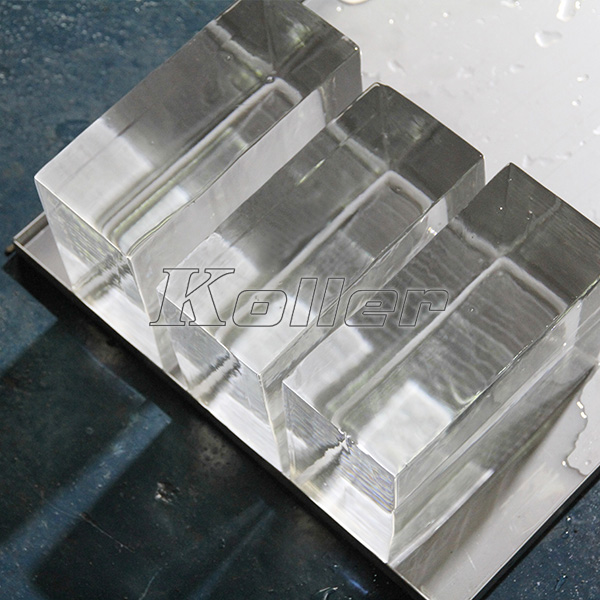
Ein Eisblock ist ein großes, massives Stück Eis, das typischerweise ist rechteckig oder zylindrisch in Form. Im Gegensatz zu kleineren Eiswürfeln, Eisblöcke werden häufig in gewerblichen und industriellen Umgebungen aufgrund ihrer Größe und langsameren Schmelzrate verwendet.
Anwendung von Eisblöcken

Eisblöcke haben verschiedene praktische Verwendungen, einschließlich:
- Lebensmittelkonservierung: Sie werden häufig in der Fischerei- und Meeresfrüchte -Industrie eingesetzt, um verderbliche Gegenstände während des Transports kalt zu halten.
- Ereigniskühlung: Eisblöcke werden häufig verwendet, um große Mengen an Getränken und Lebensmitteln bei Veranstaltungen wie Hochzeiten abzukühlen, Außenpartys, und Festivals.
- Eisschnitzen: Die Größe und Stabilität von Eisblöcken machen sie ideal für Eisschnitzen und Bildhauerung für künstlerische und dekorative Zwecke.
- Konstruktion: Großer Eisblock werden häufig zur Tunnelkühlung verwendet, meine Kühlung und Betonkühlung.
Vor- und Nachteile von Eisblöcken
- Langlebigkeit und langsamere Schmelzrate: Einer der Vorteile von Eisblöcken ist ihre lang anhaltende Natur. Aufgrund ihrer größeren Größe und Masse, Sie schmelzen mit einer langsameren Geschwindigkeit im Vergleich zu Eiswürfeln.
- Geeignet für groß angelegte Veranstaltungen und industrielle Anwendungen: Eisblöcke werden üblicherweise in industriellen Umgebungen verwendet, Catering -Operationen, und große Ereignisse, bei denen eine erhebliche Menge an Kühlung erforderlich ist.
- Begrenzte Nachteile und Komfortnetze: Während Eisblöcke ideal für bestimmte Szenarien sind, Sie sind möglicherweise nicht so leicht verfügbar oder bequem für den täglichen Gebrauch in Häusern oder im kleineren Umgebungen, die. Das Handling und Transport großer Eisblöcke kann auch schwieriger sein und spezielle Geräte erfordern.
Wie man große Eisblöcke macht?
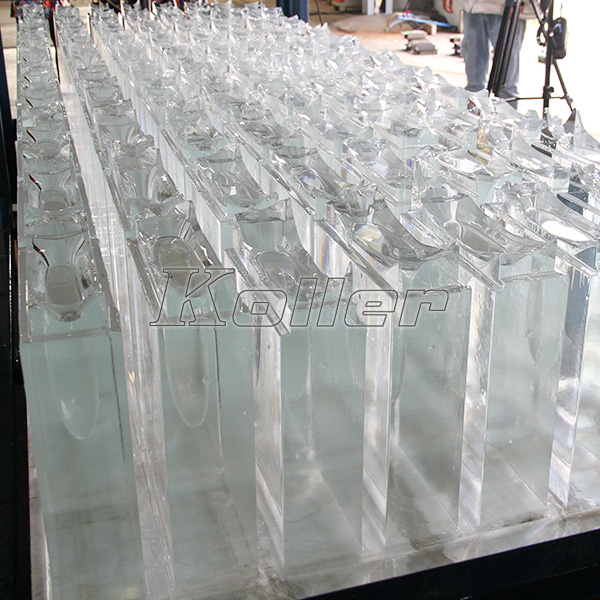
Erstellen großer Eisblöcke erfordert einen bestimmten Prozess und Geräte, um ihre Bildung und Qualität zu gewährleisten. Dieser Abschnitt bietet einen Überblick über die Schritte zur Herstellung großer Eisblöcke.
Ausrüstung und Materialien erforderlich
Große Eisblöcke machen, Sie brauchen eine Eisblockbereiter, Das ist eine spezialisierte Maschine, die zum Einfrieren von Eisblöcken entwickelt wurde. Zusätzlich, Sie benötigen Zugang zu einer zuverlässigen Wasserquelle und geeigneten Behältern oder Formen, um das Wasser beim Einfrieren zu halten.
Schritt-für-Schritt-Anleitung zum Erstellen von Eisblöcken
Bereiten Sie den Eisblockhersteller vor: Stellen Sie sicher, dass die Maschine sauber und in ordnungsgemäßem Zustand ist. Folgen Sie dem EiskaschinenherstellerAnweisungen zum Einrichten und Betrieb.
- Füllen Sie den Wasserbehälter: Reinigen Sie sauber, gefiltertes Wasser in den angegebenen Behälter oder in die Schimmelpilze. Vermeiden Sie die Verwendung von Leitungswasser, Dies kann Verunreinigungen enthalten, die die Klarheit des Eisblocks beeinflussen.
- Starten Sie den Gefrierprozess: Legen Sie den gefüllten Wasserbehälter in den Eisblockhersteller und aktivieren Sie die Maschine gemäß den Anweisungen des Herstellers. Die Maschine leitet den Gefrierprozess ein und reguliert die Temperatur für ein konsistentes Gefrierpunkt.
- Überwachen und passen Sie die Gefrierzeit an und passen Sie an: Behalten Sie den Eisblockhersteller im Auge und überwachen Sie den Fortschritt des Gefrierprozesses. Die Gefrierzeit hängt von der spezifischen Maschine und der gewünschten Eisblockgröße ab. Befolgen Sie die Richtlinien des Herstellers oder passen Sie sie anhand früherer Erfahrungen an.
- Entfernen Sie den gefrorenen Eisblock: Sobald der Gefriervorgang abgeschlossen ist, Entfernen Sie den gefrorenen Eisblock vorsichtig von der Maschine. Seien Sie vorsichtig, um Schäden oder Verletzungen während des Extraktionsprozesses zu verhindern.
- Lagern und behandeln Sie den Eisblock: Übertragen Sie den Eisblock in einen geeigneten Speicherplatz oder Container, Sicherstellen, dass es gut isoliert ist, um seinen gefrorenen Zustand aufrechtzuerhalten. Erwägen Sie, zusätzliche Isoliermaterialien zu verwenden, wie Handtücher oder Decken, seine Lebensdauer verlängern.
Tipps zum Erreichen klarer Eisblöcke
Um die Klarheit und visuelle Anziehungskraft Ihrer Eisblöcke zu verbessern, Betrachten Sie diese Tipps:
- Verwenden Sie gefiltertes oder destilliertes Wasser, um Verunreinigungen zu minimieren.
- Vermeiden Sie es, den Gefrierprozess zu stören, um gefangene Luftblasen zu minimieren.
- Experimentieren Sie mit verschiedenen Gefriervertretern, wie Richtungsfrieren, um eine klarere Eisbildung zu fördern.
FAQ: Wie lange dauert ein Eisblock??
Die Lebensdauer eines Eisblocks kann je nach Faktoren wie Größe variieren, umgebende Temperatur, Isolierung, und Luftzirkulation. Im Allgemeinen, Ein Eisblock mit Standardgröße kann unter normalen Bedingungen mehrere Stunden bis ein paar Tage dauern. Jedoch, Dies ist nur eine Schätzung, und die tatsächliche Dauer hängt von den spezifischen Umständen und dem Management des Eisblocks ab.
Abschluss
Abschließend, Eiswürfel sind ein bequemes und vielseitiges Kühlelement, das in verschiedenen Anwendungen verwendet wird. Während sie möglicherweise Einschränkungen hinsichtlich der Kühlkapazität und der Schmelzrate haben, Sie sind gut geeignet für individuelle Nutzung und Heimzwecke. Zusätzlich, Für diejenigen, die eine visuell ansprechende Option suchen, Klare Eiswürfel können durch verschiedene Methoden erreicht werden, Verbesserung der allgemeinen Ästhetik der Getränke und einem Hauch von Eleganz zu jedem Anlass verleihen. Berücksichtigen Sie die spezifischen Bedürfnisse und die gewünschten visuellen Auswirkungen, wenn Sie zwischen regulären Eiswürfeln und klaren Eiswürfeln wählen, um Ihr Kühlerlebnis zu erhöhen.


